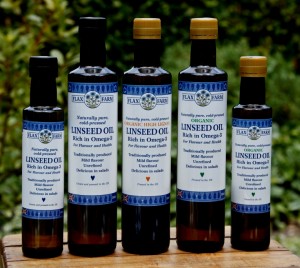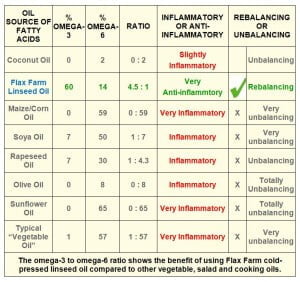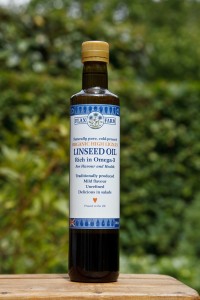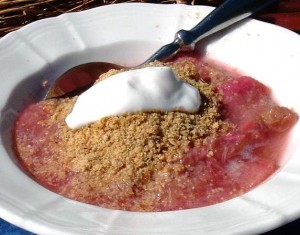F.A.Q.’s
We are here to help answer your questions about flax aka linseed
At market and on the phone we get asked lots of questions about linseed and we are pleased to be able to answer them. For those who can’t get to talk to us here are our most common questions and answers.
One of our main reasons for producing this new website was because linseed is such a wonderful food for health (and it tastes nice!) but so many people seem unsure about the best sort of linseed to and what to do with.
Hopefully this page will answer your questions. If not please send us an email from our contact page.

Q: What is the difference between Linseed and Flax?
A: Flax and Linseed are two names for exactly the same thing!
When produced as food there is no difference. Flax is the more common name in North America and Linseed is more common in Europe, where Flax refers to the taller varieties of the same plant that is grown for linen. The seeds from the “flax” grown for linen are still called linseed (in Europe) when used for making oil or even cattle cake (it is extremely good for cattle and gives them a wonderfully shiny gloss to their coats). In North America, where there is a big tradition of using linseed oil as a wood preservative there was resistance to buying cold-pressed linseed oil because people didn’t understand the significance of cold-pressing, so the manufacturers changed the name to flax and marketed it as new super food! It works the same whatever you call it. Click here for a more detailed explanation.

Q: What is the difference between gold and bronze/brown linseed?
A: The colour of linseed (flax) is not significant
The original varieties of linseed (flax) had bronze or brown seed. Since then many other varies have been developed including gold. Just like you can get green apples and red apples, both are good for you; they have absolutely identical nutritional properties. Neither has been de-hulled or toasted or in anyway processed to cause the different colour. Neither is more digestible than the other. The bronze does have a slightly nuttier flavour and is great in porridge or muesli; the gold is a little more delicately flavoured and finer ground so more versatile for adding into soup, fruit and drinks. Find out more about different varieties and colours of linseed (flax).

Q: Why do we use dark glass bottles?
A: Dark bottles protect omega-3 from light. Glass contains no plasticisers or chemicals
Dark Glass Bottles are important to keeps the light out and prevent damage to the omega-3.Plastic bottles contain plasticisers which can leach out into the oil. Glass is important because it doesn’t contain chemicals.
Glass is a sustainable material
Flax Farm uses glass bottles because it is an environmentally friendly material that can be 100% recycled for ever!
Q: Isn’t olive oil as healthy as linseed oil?
A: No it’s different; olive oil contains no omega-3

Extra virgin olive oil is a good food, rich in poly-phenol antioxidants. It contains mainly omega-9, Oleic acid, which is not an essential fat (too much just makes us fat!) and a significant amount of omega-6, Linoleic acid, which is an inflammatory fat. Olive oil contains no omega-3 (alpha-Linolenic acid). This is why olive oil tends to increase inflammation and contributes to making fat especially round the middle.
Linseed oil is mainly omega-3 which is an essential fat most of us need more of. Increasing linseed oil in you diet can improve your omega-3 levels and make you feel better. Linseed oil can help keep waist size down.
For a much healthier oil you can add linseed oil to olive oil 50/50 for most recipes.
Q:  Isn’t balanced omega-3, 6 & 9 oil better ?
Isn’t balanced omega-3, 6 & 9 oil better ?
A: Most of us don’t need extra omega-6 or 9 but most of us need more omega-3
For most of us it’s only extra omega-3 we need to rebalance all the omega-6 in our diets. As you can see in the chart above most of us get too much omega-6, which comes from every vegetable oil we eat, processed foods, chicken, pork and even bread which causes the fats in our bodies to be unbalanced so you don’t want more of it. Omega-9 is what you get in almost all fats and oils, including chicken, pork, other nuts, seeds and olive oil; in addition you body will make omega-9 when it needs it, so you never need to pay anyone for omega-9 – excess just makes slows down your utilisation of omega-3 and you fat !
Cold-pressed linseed oil is approximately 60% omega-3, the fat we need tmore of and a small amount of it does a lot to rebalance the fats in your diet and body. It adds a little omega-9 and some omega-6 so if you have linseed oil you know you won;t be going without omega-6 or 9.
Q: I eat fish do I need linseed oil as well? Isn’t fish oil better?
A: Fish doesn’t contain all that much omega-3 and as we are told by the government and nutritionists that we shouldn’t eat fish more than twice a week because of mercury and dioxins so it’s hard to get enough omega-3 from fish. We need enough omega-3 to balance all the other fats in the diet; Flax Farm cold-pressed linseed oil is an excellent, effective way to top up your omega-3.
Read the Holism Study for a comparison of the benefits of omega-3 from fish oil and flaxseed (linseed) oil
Read why Linseed (flaxseed) oil is more sustainable than krill oil as a source of omega-3
Q: I have heard people say you can’t convert linseed oil to EPA and DHA is this true?
A: We need the ALA in linseed anyway; it is the true essential fatty acid. It is the “parent” omega-3 from which DHA and EPA are made. Your body will even turn EPA and DHA back into ALA.
EPA and DHA not used efficiently by the body
Contrary to popular press the metabolism of EPA and DHA is not particularly efficient and the body even turns some of EPA back into ALA. Most people actually convert linseed ALA into longer chain DHA and EPA efficiently enough for health and as we use it in food quite freely it is an easy and effective way of getting the omega-3 we need.
Recent studies have show that although ALA is somewhat more slowly take up by the body than EPA and DHA is seems to to the body more good. EPA and DHA if taken in larger quantities get turned back into ALA until required. The Budwig Diet and Overcoming MS Recovery Plan which have been around for 70 years and 20 both respectively, use large quantities of ALA, omega-3 from Flaxseed Oil because of its efficacy in preference to fish oils.
Improved metabolism means more efficient utilization of omega-3
People with very poor diet and impaired metabolism tend to use ALA less efficiently. As time goes by increasing omega-3tends to improve metabolism of ALA omega-3. It is extremely rare for people not to be able to make good use of the omega-3 in linseed oil. Eskimos, a very small population centering on a small coastal village in Northern Ireland and some Japanese people have genetically lost the enzymes which which give them the ability to lengthen ALA to longer chain fatty acids.
Linseed oil omega-3 can be even better than fish-oils
See the HOLISM study conducted by the Overcoming Multiple Sclerosis people; patients taking linseed oil had a 60% improvement in symptoms compared fish oil patients who showed no improvement.
Linseed oil is far less processed and fresher than fish oils which means the omega-3 linseed is in better condition and not damaged,
Q: I use Rapeseed Oil, isn’t that a good source of omega-3?
A: Rapeseed oil is only a cooking oil not a healthfood.
- Flax Farm cold-pressed linseed (flaxseed) oil is far higher in omega-3. Rapeseed oil only has 7-9%, Flax Farm cold-pressed linseed (flaxseed) oil 55-60%
- Linseed oil is 700% higher in omega-3
- You have to consume 7 times more rapeseed oil than linseed oil to get the same amount of omega-3
- Rapeseed oil doesn’t improve the balance of fats in the diet it makes it worse.
- Linseed Oil is 270% more unsaturated than rapeseed oil.
- Add Flax Farm col-pressed linseed oil to your rapeseed oil 50/50% to make it healthier (but don’t use it for frying; add it at the end of cooking.)
- Rapeseed oil is often chosen for high temperature frying due to its high “smoke point”. Even if a oil or fat isn’t smoking during frying its fatty acids, including the vulnerable omega-3, will be oxidising and losing nutritional value possibly even forming harmful compounds instead.

Q: Is a high lignan linseed oil better for you?
A: Flax Farm high lignan linseed oil is useful if you don’t get enough lignans from your food
A: Lignans are amazing anti-oxidant phytonutrients (natural plant chemical compounds). Lignans are mildly phytoestrogenic and they help balance hormones. Lignans also play a protective role in protect gut and heart health.
High lignan linseed oil is great, it is more like peanut butter with the skins left on, more of the antioxidant content of the seeds. If you don’t eat much ground linseed Flax Farm cold-pressed high lignan linseed oil is a good addition to the diet.
If you need lignans to balance your hormones, for PMT or the menopause you will need to take more lignans than you will get in the oil, you will need about 25-50g per day. Lignans are in the husk, the fibre, if you need the fibre, for your digestion, again you will need to use the ground linseed. Read more about lignans
Q: Does linseed need cooking?

A. Linseed can be eaten raw or cooked
Linseed is even more digestible than oats or other seeds. It is extensively used in raw cuisine and useful as it thickens sauces without needing to be heated.
Q: Doesn’t cooking the linseed destroy its properties?
A: OK to cook it gently; it is more sensitive to light than temperature
Omega-3 is the sensitive nutrient but just like it is to cook fish you can cook linseed gently. Just don’t cook at really hot temperatures. When using in baking to to ensure if it a fairly moist mix. Ground linseed and cold-pressed linseed oil are fine in most baking but not ideal for making pastry.
Many studies have been done on the heat-stability of ground linseed and cold-pressed linseed oil. One study showed the oil and its omega-3 is unaltered after cooking at1 hour at 150ºC.
Our customers give us very good feedback on the health benefits for their joints from our Flaxjacks®, which are gently baked, which preserves the omega-3.
Q: Can Linseed oil be used in cooking?
A. Linseed oil – like all unsaturated oils – shouldn’t be used at high temperature. So treat it like extra-virgin olive oil or butter. It is fine to heat it gently. Use it for baking bread and cakes, drizzling over hot veg or in porridge or soup. But don’t fry your chips in it.
Q: I used to use linseeds for horses and we had to boil it, how come people can eat it raw?
A: Linseed is generally safe like apple pips and bitter almond kernals
We and scientists for us have researched widely this “toxicity” issue and can find nothing significant. Lots of fruit and vegetables including apple pips contain cyanide compounds. Bitter apricot kernels contain a lot of cyanide compounds, little of these cyanogenic compounds are beneficial for protection of the digestive system and for fighting cancers.
It has been calculated that 11 bitter apricot kernels could contain enough cyanide compound to be toxic for a small child but there have been no verified accounts of them causing harm. Linseed contains far less so is considered to be safe.
We and veterinary surgeons in the UK and USA can find no evidence that there is a problem with cyanide toxicity in linseed or flaxseed, even to horses.
Linseed as a growing plant has high levels of cyanogenic glycosides but the actual seed contains fairly low amounts. It has been estimated you would need to eat about 500g to get a potentially detrimental quantity.
Linseed oil contains no cyanide compounds (unless high lignan, and even then the amount is relatively low and very safe). If you (or your horses) want to avoid want cyanogenic glycosides get the omega-3 goodness of linseed from the oil.
Q: Is the raw uncooked cold-pressed linseed oil safe for horses?
A: Absolutely YES!
And it’s much easier: no more messing boiling! It was thought that the levels of cyanide compounds in the whole seed could pose a risk. Modern research shows this is not the case when horses are fed normal quantities of linseed. If you want to be safe you can be reassured; Flax Farm cold-pressed linseed oil contains no cyanide compounds.
Q: Is it important to drink extra water with linseed?
A: Whole or ground linseed absorb water; but it is hydrating
If you don;t drink enough you will absorb water too slowly from the linseed. As most of us don’t drink enough it is a good idea to have an extra glass of water with every helping of linseed. If you don’t drink a lot, are elderly or are constipated it is essential to have an extra glass or two of water. Drink plenty of water an dthe linseed actually helps keep you hydrated.
Q: Which is the best sort of linseed to have?
A: the sort of linseed which is best for you depends on what you need it for
Do you need omega-3 for combating inflammation or do you need fibre for your digestion or lignans to balance hormones?
Q: Which is better for you whole seed or ground seed?
A : Ground seed is a proper food. It gives you omega-3, protein, lignans and a better structure for your digestive tract and gives better environment for gut flora. Whole linseeds go straight through you and come out whole just as they were when they went in, which means they can do you a lot of good! Whole seeds can be useful in the short term for constipation if there are no other underlying digestive tract health issues.
A chart to help you choose the best linseed for you:
| Linseed Product | Cold-Pressed Linseed Oil | Cold-pressed Linseed Oil Capsules | Freshly Ground Linseed Meal | Whole Linseeds |
|---|---|---|---|---|
| 100% pure linseed oil | Capsules of 100% linseed Oil | Whole linseeds finely ground | Whole Linseeds/Flaxseeds | |
| What it’s good for: | Omega-3 for every cell in the body. Important for the body’s structures and systems especially skin, cardio-vasular health, immune system, muscles joints and brain. | Omega-3 for every cell in the body. Important for the body’s structures and systems especially skin, cardio-vasular health, immune system, muscles joints and brain. | Fibre, Lignans and some Omega-3. Can help the whole body and all systems. Especially digestion and hormone balance. Very low GI | Constipation |
| How much | 1-3 teaspoons day | 2-6 capsules/day (if more needed use the oil) | 2 heaped dessertspoons 1-2 times per day | 2 tablespoons 1-2/day |
Q: How do you use Linseed?
A. Use Flax Farm linseed added to food; it tastes great!
It can taste really nice so the most important thing is to use it in food in a way you enjoy it. It is there to be enjoyed. Use linseed as a food even if it can work as well as a medicine. Use the oil like a salad oil, or instead of butter or cream. Use the meal like you would ground almonds or oats. Use the whole seeds sprinkled into any food. See our recipe page for more ideas. Use the oil regularly (aim for daily is usually best). For the digestion use the meal regularly; if you miss a day of two the good effect of linseed stays with you but diminishes. For hormone balance you need to eat it every day as the HRT effect wears of quickly.
Q: Is Refrigeration for linseed (flaxseed) oil essential?
A: No Linseed does not have to be kept in the fridge
We believe we supply the best cold-pressed linseed oil ( otherwise known as flaxseed oil) in the UK; we make and bottle the oil by cold-pressing the seeds using the coolest, gentlest methods. It is designed to be used fresh as a fresh food and is not intended for long storage. We send it out absolutely fresh, within a few days of pressing.
Linseed oil, as food and therapeutic oil, has been pressed on small presses for centuries and likes to be produced on a small scale in a traditional way, a bit like home cooking – just as food like omelettes are much better when made at home than mass-produced in industrial kitchens or your gran’s sponge cakes which were great on the weekend they cooked but went stale after that – next time you are in a supermarket check-out all the weird ingredients that go into long-life packaged cakes and taste them, nothing like granny’s cakes!
When linseed, flax, oil, is produced on a larger scale industrial production often means introducing more machine processes, very high temperatures and pressures in order to extract more oil but this tends to make the oil less nice and less stable. Linseed doesn’t respond well to this sort of treatment and it often makes it start to go rancid and bitter at the point of manufacture, this then goes off like dominoes toppling and the rancidity gets worse and the oil more bitter, Refrigeration helps slow this effect down a little – but it is a bit like shutting the stable door after the horse has bolted if oil is bitter to start with. It is of significance as many of the mass-produced linseed/flax oils are expected to be in shops for many months, even up to two years, refrigeration means it gets worse slower! It doesn’t make up for it not being fresh.
Flax Farm linseed oil starts its life in better condition – we even use varieties of linseed that taste nicer – it is then supplied fresh and used fresh – we like it to be used within 2.5 months of opening or 6 months of pressing; and even at the end of this time Flax Farm cold-pressed linseed oil still tastes better than any other linseed/flax oil we (or our customers) have tasted – and taste is your best test of the quality and condition of linseed/flaxseed oil. Good Linseed (flax seed) oil should taste characteristically of linseed (flaxseed) i.e. mild, buttery, nutty, grassy, with no off or rancid bitter notes. Linseed (flaxseed) Oil should not be bitter or smell strongly.
Another thing; refrigeration for linseed /flaxseed oil is very different to something like milk. Milk goes “off” due to the activity of microbes multiplying in it. Keeping it below 4 degrees centigrade helps to stop the dangerous ones from establishing themselves. Once warmed for a short while the microbes multiply much faster and their population of becomes huge which makes the milk then go off quickly, it can even go “off” in less than one day .
However, linseed/flaxseed oil is completely different. Linseed oil/flaxseed oil is very rich in omega-3, this is a delicate and reactive molecule (it is why linseed omega-3 is so good for us; it combines readily with other molecules to create essential structures, hormones etc., that our body needs for maintenance or repair. Unfortunately, it also means it can oxidise if not properly cared for. Oxidation is slowed down slightly by cooler temperatures but as the difference between ambient temperature and refrigeration temperature is only 16 degrees this isn’t very significant (as temperature of all things starts from minus 273o Celsius and goes up to many thousands of degrees) so even as much as a few weeks at ambient temperature doesn’t really have much effect on the oil; it simply shortens the time it takes to lose its optimum freshness. We have never found this particularly noticeable. This is why it is not critical to keep it refrigerated. It continues to be nice and just as good for you as linseed oil has ever been – and bear in mind linseed oil has been used as a “health food” for thousands of years before refrigeration was available. This means that the few days between pressing and receipt of the oil makes effectively no difference to the flavour, quality or effectiveness of the oil.
Properly produced Linseed oil is actually far more heat stable than it is given credit for. We have tested it extensively and found even bottles put in hot places during summer stay mild However it is very sensitive to strong light. Left in strong sunlight linseed oil (flax seed oil) can go rancid and bitter in less than an hour. So always avoid it being left in direct light store it in the dark.
We have many enthusiastic users of the oil who never put it in the fridge, they consume it fresh and it remains fresh lovely and with all its health benefits.
Lower temperatures slow oxidation reactions down a little. So, just as the fridge is the best place for freshly ground coffee (for the same sort of reasons as above; it keeps it just a bit fresher for just a bit longer – maybe – but I have never noticed any difference!) the fridge is the best place to store your open bottle of linseed oil and the freezer is technically the very best place to store unopened bottles. It is not essential though but may extend freshness for a bit longer.
Q: Can you eat too much flax?
A: yes & no though there’s a lot of mythology surrounding this topic
Flax is very filling and if you ate a lot you wouldn’t have much room for anything else! Even though flaxseed is amazing stuff that wouldn’t be good for a balanced diet, Nutrition Facts reports that 80g per day is safely given at a Swedish health spa as a “fibre shock”. Tests have been carried out to show flaxseed can safely be consumed in large quantities. Even 9 tablespoons of flaxseed at one go were shown to be safe,
- Dr Johanna Budwig who created the Budwig Diet approximately 75 yeas ago. She recommended for tablespoons per day plus adding more ground flaxseed to juices throughout the day. The diet has had remarkable success in reversing illness,
- Dr Michael Greger recommends 1 tablespoons of ground flaxseed per day
- Scientific studies into the use of flaxseed for the menopause used 45g per. A study by the Irish Nursing Organisation, using flax as an alternative to laxatives recommended 15g-24g day (of whole flaxseed – which isn’t as kind to the tummy as ground flaxseed) for elderly, mainly, bedbound patients and was found to be effective.
- The late Dr Michael Mosley recommended aiming for 2 heaped tablespoons per day but starting off with just one to allow your gut to get used to it.
- Flax Farm recommends 1-2 tablespoons in food once or twice a day.
Sensible amounts of flax to eat daily :
The aim is to get the benefit from the flax as part of a balanced, healthy diet.
- Around 20-30ml for flaxseed oil – though the OMS diet recommends more, between 20-40ml per day and the Budwig diet approximately 90ml or more,
- Ground Flaxseed up to 45g (about four tablespoons) spread over a couple or more meals.
- Whole flaxseeds approximately 45g per day.
Do drink an extra glass or two with meals containing ground or whole flaxseed. It will ensure you stay fully hydrated and get the best effect from the flaxseed.
Q: Is organic linseed (flaxseed) oil better?
A: Not Necessarily; quality & freshness are more important
More important is that it has a light, mild nutty flavour which indicates that it is really fresh and unpurified and has come from top quality seed. Organic linseed is guaranteed to have been grown without harmful chemicals but doesn’t mean it is grown to a better standard or that it has been harvested and stored correctly, which are essential for quality linseed oil. Organic isn’t as important for linseed/flax as the seeds are protected in capsules as they grow rather like poppyseeds.
However Flax Farm is organically certified with Organic Farmers and Growers Flax Farm produces organic linseed and organic fresh cold-pressed linseed (flaxseed). We feel “organic” is a far better system which hopefully will become more common in all farming, especially salad crops in time.
The flavour can you tell if it is good linseed oil
The most important way to judge the quality of linseed oil is to taste it. Good, carefully produced fresh linseed oil tastes of subtly of linseed is mild and delicate which is good. Unfortunately if flaxseed oil – even organic – is processed with a bit too much pressure and temperature and isn’t fresh it can easily become bitter which means it has started to go rancid and generated oxides within itself, these are just as bad for you (the bitter compounds in flax oil are especially bad for the liver) as any other chemical. So the best oil for you is the one which has the delicate nutty flavour of linseed and and is mild, amd creamy with no hint of bitterness.which shows it has been well produced.

